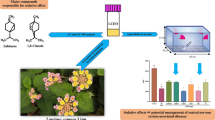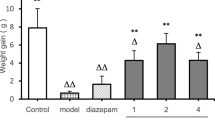Abstract
Microtoena patchoulii (Labiatae) is a perennial herb that grows in southern China. In the present study, the sedative activity of the essential oil of the leaves was evaluated using mice when the volatile oil was administered by inhalation. The inhalation of the oil by mice significantly reduced the spontaneous motor activity. Fractionation of the oil revealed that the main constituents in the oil were 1-octen-3-ol, terpinolene, patchouli alcohol, and methyl salicylate. Each 1-octen-3-ol, terpinolene, or patchouli alcohol significantly reduce the locomotor activity when it was administered singly. However, the essential oil fraction containing both patchouli alcohol and methyl salicylate did not exhibit any effects. It is suggested that methyl salicylate might negate the sedative effect of patchouli alcohol, and that the concentration ratios of the compounds in vapor would play important roles as sedatives. In order to clarify the mechanism of action, the effects of these compounds on caffeine-induced excitation and pentobarbital-induced elongation of sleeping time in mice were tested. Each 1-octen-3-ol or terpinolene reduced the locomotor activity excited by caffeine to those of normal levels. Elongation of sleeping time induced by pentobarbital was further elongated by the inhalation of terpinolene, but not by that of 1-octen-3-ol. It is indicated that terpinolene is a potent suppressor of the central nervous system.










Similar content being viewed by others
References
Senpuku M, Nonaka K, Ito M, Honda G (2007) Chemical composition of the essential oil of Microtoena patchoulii [(C.B. Clarke ex J.D. Hooker) C.Y. Wu et Hsuan]. J Essent Oil Res 19:336–337
Zhao Z, Lu J, Leung K, Chan CL, Jiang ZH (2005) Determination of patchoulic alcohol in Herba Pogostemonis by GC–MS–MS. Chem Pharm Bull 53:856–860
Sinha D, Efron D (2005) Complementary and alternative medicine use in children with attention deficit hyperactivity disorder. J Paediatr Child Health 41:23–26
Takemoto H, Ito M, Shiraki T, Yagura T, Honda G (2008) Sedative effects of vapor inhalation of agarwood oil and spikenard extract and identification of their active components. J Nat Med 62:41–46
Takemoto H, Yagura T, Ito M (2009) Evaluation of volatile components from spikenard: valerena-4,7(11)-diene is a highly active sedative compound. J Nat Med 63:380–385
The Society of Japanese Pharmacopoeia (2007) The Japanese Pharmacopoeia Fifteenth Edition (JP XV). Yakuji-Nippo, Tokyo, p 99
Aleu J, Hanson JR, Galán RH, Collado IG (1999) Biotransformation of the fungistatic sesquiterpenoid patchoulol by Botrytis cinerea. J Nat Prod 62:437–440
Bais HP, Dattatreya BS, Ravishankar GA (2003) Production of volatile compounds by hairy root cultures of Cichorium intybus L. under the influence of fungal elicitors and their analysis using solid-phase micro extraction gas chromatography–mass spectrometry. J Sci Food Agric 83:769–774
Wallenstein S, Zucker CL, Fleiss JL (1980) Some statistical methods useful in circulation research. Circ Res 47:1–9
Mochizuki M, Akagi K, Inoue K, Shimamura K (1998) A single dose toxicity study of magnesium sulfate in rats and dogs. J Toxicol Sci 1:31–35
RIFM EXPERT Panel, Belsito D, Bickers D, Bruze M, Calow P, Greim H, Hanifin JM, Rogers AE, Saurat JH, Sipes IG, Tagami H (2008) A toxicologic and dermatologic assessment of cyclic and non-cyclic terpene alcohols when used as fragrance ingredients. Food Chem Toxicol 11:S1–S71
Posternak JM, Dufour JJ, Rogg C, Vodoz CA (1975) Toxicological tests on flavouring matters. II. Pyrazines and other compounds. Food Cosmet Toxicol 13:487–490
Grassmann J, Hippeli S, Spitzenberger R, Elstner EF (2005) The monoterpene terpinolene from the oil of Pinus mugo L. in concert with alpha-tocopherol and beta-carotene effectively prevents oxidation of LDL. Phytomedicine 12:416–423
Komiya M, Takeuchi T, Harada E (2006) Lemon oil vapor causes an anti-stress effect via modulating the 5-HT and DA activities in mice. Behav Brain Res 172:240–249
Mathews DF (1972) Response patterns of single neurons in the tortoise olfactory epithelium and olfactory bulb. J Gen Physiol 60:166–180
Chitarra GS, Abee T, Rombouts FM, Dijksterhuis J (2005) 1-Octen-3-ol inhibits conidia germination of Penicillium paneum despite of mild effects on membrane permeability, respiration, intracellular pH, and changes the protein composition. FEMS Microbiol Ecol 54:67–75
McMahon C, Guerin PM, Syed Z (2001) 1-Octen-3-ol isolated from bont ticks attracts Amblyomma variegatum. J Chem Ecol 27:471–486
Sawahata T, Shimano S, Suzuki M (2008) Tricholoma matsutake 1-ocen-3-ol and methyl cinnamate repel mycophagous Proisotoma minuta (Collembola: Insecta). Mycorrhiza 18:111–114
Ramoni R, Vincent F, Grolli S, Conti V, Malosse C, Boyer FD, Nagnan-Le Meillour P, Spinelli S, Cambillau C, Tegoni M (2001) The insect attractant 1-octen-3-ol is the natural ligand of bovine odorant-binding protein. J Biol Chem 276:7150–7155
Linck VM, da Silva AL, Figueiró M, Piato AL, Herrmann AP, Dupont Birck F, Caramão EB, Nunes DS, Moreno PR, Elisabetsky E (2009) Inhaled linalool-induced sedation in mice. Phytomedicine 16:303–307
Lapczynski A, Jones L, McGinty D, Bhatia SP, Letizia CS, Api AM (2007) Fragrance material review on methyl salicylate. Food Chem Toxicol 45:S428–S452 (Safety data for methyl salicylate)
Bhatia SP, Letizia CS, Api AM (2008) Fragrance material review on patchouli alcohol. Food Chem Toxicol 46:S255–S256
Taniguchi Y, Deguchi Y, Saita M, Noda K (1994) Antinociceptive effects of counterirritants. Nippon Yakurigaku Zasshi 104:433–446
Block LL, Goon DJW, Rolf D (1998) Inhalation therapy decongestant with foraminous carrier. United States Patent 6090403
Nehlig A, Daval JL, Debry G (1992) Caffeine and the central nervous system: mechanisms of action, biochemical, metabolic and psychostimulant effects. Brain Res Brain Res Rev 17:139–170
Chweh AY, Swinyard EA, Wolf HH (1987) Hypnotic action of pentobarbital in mice: a possible mechanism. Exp Neurol 97:70–76
Sadre NL, Tiwari NM (1966) Prolongation of chloral hydrate and pentobarbitone sleeping time by chlorpromazine and histamine in mice. Arch Int Pharmacodyn Ther 163:6–10
Tsuchiya T, Tanida M, Uenoyama S, Nakayama Y, Ozawa T (1991) Effects of olfactory stimulation on the sleep time induced by pentobarbital administration in mice. Brain Res Bull 26:397–401
Koo BS, Park KS, Ha JH, Park JH, Lim JC, Lee DU (2003) Inhibitory effects of the fragrance inhalation of essential oil from Acorus gramineus on central nervous system. Biol Pharm Bull 26:978–982
Author information
Authors and Affiliations
Corresponding author
Rights and permissions
About this article
Cite this article
Ito, K., Ito, M. Sedative effects of vapor inhalation of the essential oil of Microtoena patchoulii and its related compounds. J Nat Med 65, 336–343 (2011). https://doi.org/10.1007/s11418-010-0502-x
Received:
Accepted:
Published:
Issue Date:
DOI: https://doi.org/10.1007/s11418-010-0502-x




